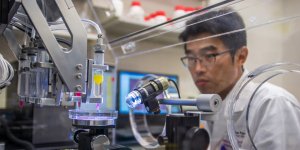Science News
Using an engineered protein, researchers were able to improve heart function in mice and protect the animals from heart attacks. »
A poor night’s sleep can leave you feeling foggy and drowsy throughout the day. Sleep deprivation has also been associated with higher risks of weight gain and obesity. »
Astronomers have uncovered a near-record breaking supermassive black hole, weighing 17 billion suns, in an unlikely place: in the center of a galaxy in a sparsely populated area of the universe. »
NASA's Near-Earth Object Wide-field Survey Explorer (NEOWISE) mission has released its second year of survey data. The spacecraft has now characterized a total of 439 NEOs since the mission was re-started in December 2013. Of these, 72 were new discoveries. »
Our eyes constantly send bits of information about the world around us to our brains where the information is assembled into objects we recognize. Along the way, a series of neurons in the eye uses electrical and chemical signals to relay the information. »
A NASA-led team of scientists has developed the first-ever method for detecting the presence of different types of underground forest fungi from space, information that may help researchers predict how climate change will alter forest habitats. »
Increasing the level of a naturally-produced protein, called tristetraprolin, significantly reduced or protected mice from inflammation, according to researchers. »
Astronomers had previously identified G1.9+0.3 as the remnant of the most recent supernova in our Galaxy. It is estimated to have occurred about 110 years ago in a dusty region of the Galaxy that blocked visible light from reaching Earth. »
An experimental dengue vaccine protected all the volunteers who received it from infection with a live dengue virus. »
Astronomers were watching when comet P/2016 BA14 flew past Earth on March 22. At the time of its closest approach, the comet was about 2.2 million miles (3.5 million kilometers) away, making it the third closest comet flyby in recorded history. »
For what may be the first time, NOAA and partner scientists eavesdropped on the deepest part of the world’s ocean and instead of finding a sea of silence, discovered a cacophony of sounds both natural and caused by humans. »
Two comets that will safely fly past Earth later this month may have more in common than their intriguingly similar orbits. They may be twins of a sort. »
A new discovery by Arizona State University scientists shows that two specific metallic elements in the right kinds of clay can kill disease-causing bacteria that infect humans and animals. »

A monoclonal antibody derived from a person who survived Ebola virus disease protected non-human primates when given as late as 5 days after Ebola infection. »
The first operational dive of Okeanos Explorer’s 2016 season, on February 27, explored depths of over 4,000 meters northeast of Necker Island (Mokumanamana) in the Hawaiian Archipelago. »
For the first time, scientists have observed ripples in the fabric of spacetime called gravitational waves, arriving at the earth from a cataclysmic event in the distant universe. This confirms a major prediction of Albert Einstein's 1915 general theory of relativity and opens an unprecedented new window onto the cosmos. »
A small asteroid that two years ago flew past Earth at a comfortable distance of about 1.3 million miles (2 million kilometers) will safely fly by our planet. »
National Institutes of Health and Massachusetts Institute of Technology scientists identified a previously unappreciated role for the soft palate during research to better understand how influenza (flu) viruses acquire the ability to move efficiently between people. »

If you have ever heard a clap of thunder, the boom of fireworks, or the roar of a supersonic jet, you already know how shock waves sound. Now a team of NASA researchers has generated images that show how the remarkable waves look. »

NASA Astronaut Scott Kelly captured this photo on Oct. 2, 2015, from the International Space Station and wrote "Early morning shot of Hurricane Joaquin from space station before reaching Bahamas." »
In the first-ever sequencing of the entire octopus genome, researchers discovered unusual features that shed light on octopus evolution and biology, and set the stage for future studies on complex nervous system development. »

Scientists have found this year’s Gulf of Mexico dead zone — an area of low to no oxygen that can kill fish and marine life — is, at 6,474 square miles, above average in size and larger than forecast by NOAA in June. »
Researchers identified a sensor that detects the Earth’s magnetic field in nerve cells of tiny worms. »
A protein previously linked to acute symptoms following a traumatic brain injury (TBI), may also be responsible for long-term complications that can result from TBI, according to a new research. »

Mysterious objects called brown dwarfs are sometimes called "failed stars." They are too small to fuse hydrogen in their cores, the way most stars do, but also too large to be classified as planets. But a new study suggests they succeed in creating powerful auroral displays, similar to the kind seen around the magnetic poles on Earth. »
Carrying a gene variant that affects the release of a specific brain protein may put one at greater risk of developing an alcohol use disorder, according to the results of a recent animal study. »
CERN's Large Hadron Collider announced that researchers discovered a remarkable class of particles known as pentaquarks that could reshape scientists' understanding about the properties of matter. »
Spider-like cells inside the brain, spinal cord and eye hunt for invaders, capturing and then devouring them. These cells, called microglia, often play a beneficial role by helping to clear trash and protect the central nervous system against infection. But a new study shows that they also accelerate damage wrought by blinding eye disorders, such as retinitis pigmentosa. »
Though they occupy a small fraction of Earth's surface, freshwater wetlands are the largest natural source of methane emitted into the atmosphere. New research identifies an unexpected process that acts as a key gatekeeper in regulating methane emissions from these freshwater environments. »
New images of Ceres from NASA's Dawn spacecraft provide more clues about its mysterious bright spots, and also reveal a pyramid-shaped peak towering over a relatively flat landscape. »
For more than 30 million years after dinosaurs first appeared, they remained inexplicably rare near the equator, where only a few small-bodied meat-eating dinosaurs made a living. Scientists have developed a new explanation: rapid vegetation changes related to climate fluctuations between arid and moist climates and the resulting extensive wildfires of the time. »
Researchers of the University of Virginia School of Medicine recently discovered a series of channels that surround blood vessels within the brains of mice. This system, managed by the brain’s glial cells, was termed the glymphatic system. It moves cerebrospinal fluid, a clear liquid surrounding the brain and spinal cord, quickly and deeply thoughout the brain, removing waste. »
A relatively new method of targeting specific DNA sequences in zebrafish could dramatically accelerate the discovery of gene function and the identification of disease genes in humans. »
New images of dwarf planet Ceres, taken by NASA's Dawn spacecraft, show the cratered surface of this mysterious world in sharper detail than ever before. »
Several studies have shown that humans and other mammals produce more milk during second pregnancies than first pregnancies. This suggests that the first pregnancy causes a long-lasting change in the mammary gland. »
As part of an unusual mortality event investigation, a team of scientists has discovered that dead bottlenose dolphins stranded in the northern Gulf of Mexico since the start of the Deepwater Horizon oil spill have lung and adrenal lesions consistent with petroleum product exposure. »
Cellular structures called microtubules are tagged with a variety of chemical markers that can influence cell functions. The pattern of these markers makes up the “tubulin code” and scientists have uncovered the mechanism behind one of the main writers of this code, tubulin tyrosine ligase-7 (TTLL7). »
Roundworms share a considerable amount of genetic material with humans. Enough to make them the good candidates for a new study designed to determine how low-gravity environments affect astronauts. »
When animals are present, children with autism spectrum disorders (ASDs) have lower readings on a device that detects anxiety and other forms of social arousal when interacting with their peers. »
Researchers developed a tool that can turn specific sets of neurons on and off in mice to affect behavior. »
Thunderstorms that form at night, without a spark from the sun's heat, are a mysterious phenomenon. This summer, scientists will be staying up late in search of some answers. »

A new NASA study finds the last remaining section of Antarctica's Larsen B Ice Shelf, which partially collapsed in 2002, is quickly weakening and likely to disintegrate completely before the end of the decade. »
NASA laboratory experiments suggest the dark material coating some geological features of Jupiter's moon Europa is likely sea salt from a subsurface ocean, discolored by exposure to radiation. »
A new study shows that it is possible to use an imaging technique called cryo-electron microscopy (cryo-EM) to view, in near-atomic detail, the architecture of a metabolic enzyme bound to a drug that blocks its activity. This advance provides a new path for solving molecular structures that may revolutionize drug development. »
For the first time in a lab, researchers found evidence supporting the commonly held belief that people with certain physiologies lose less weight than others when limiting calories. »
Nuclear Spectroscopic Telescope Array, or NuSTAR, has found evidence that a massive star exploded in a lopsided fashion, sending ejected material flying in one direction and the core of the star in the other. »
A team led by Dr. Thomas Geisbert at the University of Texas Medical Branch (UTMB) at Galveston, in collaboration with Tekmira Pharmaceuticals in Vancouver, Canada, have been developing therapies that can target specific strains of the Ebola virus. »
A team led by Dr. Daniel Mirman at Drexel University and Dr. Myrna F. Schwartz at the Moss Rehabilitation Research Institute set out to better understand the basis of language by studying people with aphasia using both neuroimaging and behavioral assessment. »
The April 25, 2015, magnitude 7.8 Gorkha earthquake in Nepal created waves of energy that penetrated into Earth's upper atmosphere in the vicinity of Nepal, disturbing the distribution of electrons in the ionosphere. »
Peering into the heart of the Milky Way galaxy, NASA's Nuclear Spectroscopic Telescope Array (NuSTAR) has spotted a mysterious glow of high-energy X-rays that, according to scientists, could be the "howls" of dead stars as they feed on stellar companions. »


